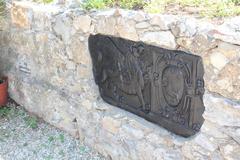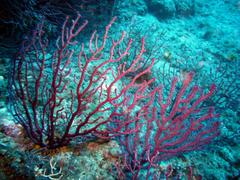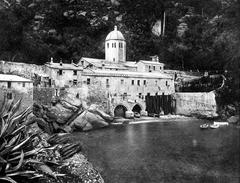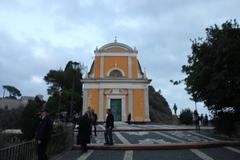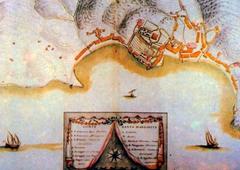Zoagli and Rapallo Visiting Guide: Hours, Tickets, and Attractions
Date: 14/06/2025
Introduction to Zoagli and Rapallo Historical Sites
Nestled along the breathtaking Ligurian coast, Zoagli and Rapallo are two of Italy’s most captivating seaside destinations. Renowned for their rich history, stunning landscapes, and vibrant cultural traditions, these towns serve as gateways to Liguria’s artistic and artisanal heritage. From Zoagli’s roots in ancient Ligurian and Roman times to Rapallo’s iconic seaside castle and spiritual sanctuaries, the region promises an immersive experience for every traveler. This guide presents a detailed overview of historical highlights, essential visitor information—such as opening hours and ticketing—and practical tips for making the most of your time in Zoagli and Rapallo. For additional details, consult resources like the Italy Traveller Guide, Adventurous Kate’s Rapallo Guide, and the Rapallo tourism website.
Contents Overview
- Zoagli: Historical Overview
- Zoagli: Cultural and Social Significance
- Practical Visitor Information for Zoagli
- Rapallo: Main Attractions and Things to Do
- Rapallo: Practical Visitor Information
- Castello di Rapallo: In-Depth Guide
- Summary and Recommendations
- Sources
Zoagli: Historical Overview
Prehistoric and Ancient Origins
Zoagli’s history extends back to the Liguri Tigulli, an ancient Ligurian tribe, with archaeological evidence of settlements preceding Roman times (Italy Traveller Guide). As a village along the Roman Via Aurelia, Zoagli (then “Joagi”) served as a strategic waypoint, confirming its early significance in regional trade and communication (FamilySearch).
Medieval Development and Feudal Rule
By the 12th century, Zoagli was under the control of the influential Fieschi family. In the 13th century, it became subject to the Republic of Genoa, ushering in an era of relative stability, increased trade, and the construction of defensive coastal towers (Italy Traveller Guide).
Silk Weaving and Economic Flourishing
From the 18th century, Zoagli developed a reputation for its silk weaving industry. Renowned for luxurious damasks and velvets, Zoagli’s “seterie” supplied fabrics to European aristocracy, a tradition that endures today in local workshops (La Mia Liguria).
Integration into Modern Italy
After the Napoleonic era, Zoagli was incorporated into the Kingdom of Sardinia and, in 1861, into unified Italy. The town shifted from feudal to modern administrative structures, aligning its future with the broader Ligurian coast (Italy Traveller Guide).
The Rise of Tourism and Artistic Patronage
In the late 19th and early 20th centuries, Zoagli attracted artists and intellectuals, including Friedrich Nietzsche, Ezra Pound, and Wassily Kandinsky. Elegant villas, scenic cliffside paths (“creuze”), and the restoration of historic landmarks like Castello Canevaro contributed to its reputation as an artistic haven (La Mia Liguria, Italy Traveller Guide, International Living).
World War II and Reconstruction
World War II brought devastation to Zoagli, particularly through the 1943 bombing that targeted its railway bridge and historic center. In the postwar years, residents undertook significant reconstruction, restoring architectural and cultural heritage (Il Tigullio).
Zoagli: Cultural and Social Significance
Literary and Artistic Heritage
Zoagli has long been a source of inspiration for artists, writers, and philosophers. Ezra Pound, Friedrich Nietzsche, and Vasilij Kandinskij each found creative refuge here, cementing the town’s role as a “poetic redoubt” (italoamericano.org, wikipedia.org, guidadigenova.it). Rapallo further enriches the region’s cultural life with art galleries, studios, and local festivals (expatexchange.com).
Traditional Craftsmanship: Silk and Velvet Weaving
Zoagli’s “seterie” have produced high-quality silk and velvet since the Middle Ages. Visitors can observe traditional weaving techniques in local workshops and purchase unique textiles (wikipedia.org, portofinocoast.it, seterie di Zoagli).
Community Life and Local Traditions
Both Zoagli and Rapallo are characterized by lively piazzas, communal events, and a culture of hospitality. Annual festivals, food fairs, and religious processions foster a strong sense of community (expatexchange.com, lecinqueterre.org).
Religious and Spiritual Sites
Notable religious landmarks include the 16th-century Madonna delle Grazie sanctuary in Zoagli and the Santuario Nostra Signora di Montallegro, accessible by cableway from Rapallo (guidadigenova.it, hugotrumpy.it). These sites host important religious and community events.
Architectural and Historical Landmarks
Key sites include the Saracen Towers, Castello Canevaro, and the Castello di Sem Benelli in Zoagli, as well as Rapallo’s Castello sul Mare and historic town center (portofinocoast.it, guidadigenova.it). The piazzetta in Zoagli and its labyrinth fountain mark the start of scenic cliffside promenades.
Festivals and Events
Highlights include Zoagli’s underwater Madonna del Mare festival, religious processions, and food fairs featuring Ligurian cuisine (wikipedia.org, expatexchange.com).
Culinary and Outdoor Culture
Local restaurants serve fresh seafood, pesto, and focaccia, while outdoor activities—from hiking to boating—make the most of the region’s natural beauty (expatexchange.com, outdooractive.com).
Practical Visitor Information for Zoagli
Main Attractions:
- Cliffside promenades (open year-round, free access)
- Castello Canevaro (advance booking recommended)
- Saracen Towers and piazzetta
- Silk weaving workshops (guided tours available; book in advance)
Visiting Hours and Tickets:
- Outdoor attractions: open year-round, free
- Castello Canevaro and select workshops: seasonal hours, ticketed
- Annual events may require advance reservations or tickets
Accessibility:
While many outdoor areas are accessible, some historic paths and buildings present challenges for those with limited mobility. The cableway to Montallegro offers accessible entry.
Nearby Attractions:
- Chiavari (medieval town)
- Portofino Natural Park
- Cinque Terre villages
Travel Tips:
- Zoagli is accessible by train and bus from major Ligurian cities
- Comfortable footwear is recommended for uneven terrain
- Local tourism offices provide maps and updated information
Rapallo: Main Attractions and Things to Do
Seaside Promenade (Lungomare Vittorio Veneto)
A lively waterfront promenade lined with palms, cafes, and markets. Seasonal events and local markets add vibrancy throughout the year (Adventurous Kate).
Rapallo Castle (Castello sul Mare)
Built in 1551 to protect against pirates, this iconic seaside castle now hosts exhibitions and events. A highlight during the July Festa di Nostra Signora di Montallegro, when fireworks illuminate the castle (Adventurous Kate).
Hours: 10:00 AM–6:00 PM daily (varies during events)
Tickets: Free entry; some exhibitions may charge a fee
Accessibility: Partial (some stairs and cobbles)
Santuario di Nostra Signora di Montallegro
Accessible by cable car, this 16th-century sanctuary offers panoramic views and hiking opportunities (Never Ending Voyage).
Cable Car Hours: 9:00 AM–6:00 PM (seasonal changes)
Tickets: Available at station or online
Accessibility: Cable car is wheelchair accessible
Historic Center and Via Mazzini
Stroll cobbled streets lined with artisan shops, bakeries, and lace stores. Piazza Cavour and Piazza Garibaldi offer classic Italian atmosphere (Never Ending Voyage).
Villa Tigullio and Lace Museum
A villa set in lush gardens, home to the Museo del Merletto, which celebrates Rapallo’s lace-making heritage (Adventurous Kate).
Beaches and Seaside Activities
Swim at Rapallo’s pebble beach or nearby San Michele di Pagana. Water sports and boat rentals are available.
Day Trips and Outdoor Activities
Easy access to Santa Margherita Ligure, Portofino, Camogli, and the Cinque Terre, plus hiking trails for all skill levels (Never Ending Voyage).
Culinary Experiences
Taste Ligurian specialties like seafood, trofie al pesto, and focaccia at local restaurants and markets. Enjoy aperitivo culture along the promenade (Adventurous Kate).
Rapallo: Practical Visitor Information
Main Attractions:
- Rapallo Castle: 10:00 AM–6:00 PM (check for special events)
- Santuario di Nostra Signora di Montallegro: accessible by cable car, 9:00 AM–6:00 PM
- Villa Tigullio Lace Museum: 10:00 AM–5:00 PM (verify times)
Tickets:
- Castello: usually free entry, some exhibitions ticketed
- Cable car: tickets at station or online
- Museum: ticket required
Accessibility:
Most main attractions are partially accessible; cable car is wheelchair friendly but some sites and trails have uneven surfaces.
Family-Friendly:
Flat promenades, beaches, parks, and family-oriented restaurants create a welcoming environment for children.
Travel Tips:
Rapallo is easily reached by train, car, or from Genoa airport. Walking is the best way to explore the historic center.
Castello di Rapallo: In-Depth Guide
History and Significance
Castello di Rapallo was constructed in 1551 as a defense against pirate raids and later served as a prison. Today, it stands as a symbol of the town and a venue for exhibitions and community events.
Visiting Information
- April–October: Tue–Sun, 10:00 AM–6:00 PM
- November–March: Sat–Sun, 10:00 AM–4:00 PM
- Admission: €5 (adults), €3 (EU citizens 18–25), free for children under 18, seniors 65+, and Rapallo residents
- Guided Tours: Weekends/public holidays at 11:00 AM and 3:00 PM; advance booking recommended
Accessibility
Some areas are accessible via ramps, but overall accessibility is limited due to the castle’s medieval structure.
Other Historical Sites
- Sanctuary of Montallegro: Accessible by cable car, panoramic views, and spiritual significance
- Church of San Francesco: 13th-century church with frescoes
- Torre Civica: Medieval civic tower
Practical Tips
- Getting There: Train (Genoa–La Spezia line), A12 motorway (exit Rapallo), or Genoa airport
- Accommodation: Book early for popular periods (e.g., Jubilee year)
- Nearby Dining: Seaside restaurants specialize in Ligurian dishes
Summary and Visitor Recommendations
Zoagli and Rapallo offer a remarkable combination of history, culture, and natural beauty. Explore Zoagli’s ancient roots, silk weaving tradition, and resilient spirit, then enjoy Rapallo’s seaside castle, spiritual sanctuaries, and lively promenades. Accessible public transportation, a wealth of festivals, and unique culinary experiences make these towns ideal for travelers seeking both tradition and relaxation.
For the best experience:
- Check opening hours and book tours in advance, especially for major festivals or during the Jubilee year
- Download the Audiala app for up-to-date information and exclusive offers
- Explore both towns on foot to fully appreciate their charm
For further details, visit official tourism sites and use the resources listed below.
Sources and Further Reading
- Italy Traveller Guide
- La Mia Liguria
- Il Tigullio
- International Living
- Italo Americano
- Guida di Genova
- Expat Exchange
- Portofino Coast
- Adventurous Kate
- Never Ending Voyage
- Wikipedia Zoagli
- Hugotrumpy.it
- Italy Vacation Specialists
